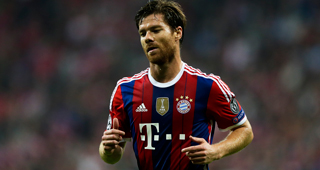Retiring from international football and facing obsolescence with Real Madrid, Xabi Alonso was coming out of the summer and into the 14-15 season like the end was swiftly approaching. Throughout his career, Alonso has been more arthouse than blockbuster, but he’s finally getting a showy, scene-stealing supporting role with Bayern Munich. Alonso always played different roles for club and country and now at Bayern, he’s allowed Pep Guardiola to load up on attacking players with how organized he keeps the middle of the pitch.
With Real Madrid and before that at Liverpool when he was at his physical peak, Alonso’s function was to spread the ball out wide to make the defense cover as much ground as possible and create space for the likes of Cristiano Ronaldo while sending glitzy through-balls to forward runs when the opportunity arose. There was no limit to Alonso’s passing range and his vision, while being chiefly responsible for keeping the ball moving with shorter, facilitating passes.
When playing for Spain, Alonso gave cover to Xavi and played a lot of short, patient passes in their slow build-up. Alonso was the drummer keeping beat to give Xavi and Andres Iniesta room to improvise in the horn section. Alonso was rarely a celebrated member of those legendary 2008, 2010 and 2012 teams, but his influence on what made that run so effective has grown in time, particularly with how many of those matches were won by narrow, low-scoring margins. Spain compromised some attacking prowess in using Alonso in a double-pivot with Sergio Busquets and maybe they would have won a few more 3-1 and 4-0 matches to increase the entertainment quotient with a different XI, but playing two deep-lying midfielders gave Vicente del Bosque the confidence of needing just one goal to win.
Alonso left Real Sociedad to join Liverpool at the age of 22 and downloaded some of those distinctly English qualities of pace and physicality, yet still rebelling against the fake hustle of over-tackling, while remaining quintessentially Spanish in his technique and demeanor of calm. Alonso returned to Spain in 2009 by going to Real Madrid just as Barça was beginning their run of four La Liga titles in five seasons. Alonso was a steadying and positive force on and off the pitch on the tumultuous time of transition under José Mourinho.
With Bayern, a somewhat improbable move considering his history battling Guardiola in all of those Clásicos and that it took a ton of injuries for a need to arise, Alonso is having a nearly unexplainable late career surge. The Alonso/Toni Kroos transfer were effectively an after the fact trade and has been the rare circumstance where both clubs came out better for it.
Alonso is averaging well over 100 passes per match and had 216 touches in one match, while also recording more long balls than all but one goalkeeper in the Bundesliga. Earlier in the season before his production regressed to the still absurd mean, Alonso was averaging nearly 20 long balls per 90 minutes.
With Bastian Schweinsteiger back from injury, we’ll finally begin to see the real Bayern Alonso that Guardiola plans for the knockout phase of the Champions League. Schweinsteiger and Alonso will form a double-pivot that will be a savvier and more grizzled version of that Alonso and Javier Mascherano partnership that led Liverpool to the 2005 Champions League.
Guardiola has leaned so heavily upon Alonso that he’s used him as an opportunity to shoehorn in Robert Lewandowski, Arjen Robben, Franck Ribery, Thomas Müller and Mario Götze onto the pitch at the same time as one of the biggest fleets of attacking players we’ve ever seen. Alonso has the unique ability to feed all of the tentacles of that beast while providing adequate defensive cover. Even with injuries, Guardiola has too much depth to manage with just 11 men and one ball, but Alonso makes everyone happy with his distribution and selfless play. Playing without Schweinsteiger until now and with Philipp Lahm now out, Alonso has played the elder leader role that wasn’t expected when he was a late summer window transfer afterthought.
The Guardiola of Barça was a Pope loyal to the scriptures of tiki-taka and bowing at the altar of Lionel Messi, but the Guardiola of Bayern is a mad scientist where we don’t know how they’ll look and no one individual player is bigger than the club. Alonso on the pitch gives Guardiola an extension of his foot in the lab.
But there are realities of a 33-year-old covering that much space when Bayern inevitably meets Real Madrid or Atlético Madrid that we’ll need to see Guardiola adapt what works so well in the Bundesliga and in the early stages of the Champions League.
Alonso is on the cusp of retirement and his move to Germany allows him to add two more attractive qualities to his already impressive CV in Bundesliga experience and playing under Guardiola. Alonso will have a brief apprenticeship as an assistant, but he almost certainly will be managing at one of those five or six elite clubs by the time he’s 40.
For now, Alonso is fine defying time trying to add a third Champions League title and be on the pitch for it after being on suspension last season when Real Madrid beat Atlético Madrid.



